In previous posts we've looked at some of the steps needed to set up your own label. While the idea of having your own label might seem romantic, the truth is that it's a business and like all business you need to keep track of your product, sales, promos, purchase orders, invoices and business contacts.
The best way of doing this is to have a database. Now I realize that databases aren't sexy or hip or have the allure of a new piece of gear for your studio, but in the long run could have an equal, if not greater, impact on the success of your label.
There are a lot of databases to choose from. I've used a few and the one I've found the easiest and fastest to use is a less known one called Panorama by a company called Provue. Turns out Provue's been creating software for a very long time. In fact the only other company that has been designing software to run on Apple computers longer than Provue is Microsoft! You read that right, Microsoft.
READ THE FULL ARTICLE
Postings by Scott August, about the Native American style flute,
the Pueblo/Anasazi flute, Xiao and the Southwest
Wednesday, December 31, 2008
Tuesday, December 30, 2008
Understanding Pentatonic Scales
What are pentatonic scales? How are they constructed? What makes them different than major and minor scales? Why are they the most common scale used in the world?
In this article we're going to take a closer look at these very popular scales and explain them in an easy to understand nonacademic way.
Scales are one of the most important building blocks of music. Notes from scales, combined with rhythm, form the basis of melodies. A haunting, solo melody can be a rich and rewarding musical expression. Therefore a basic knowledge of scales is beneficial to anyone that wishes to make music, especially if they are creating their own tunes or just improvising ("playing from the heart").
In the two previous articles we looked at diatonic major and minor scales and then the diatonic modes respectively. A good understanding of these principles will help you with the subject of this post exploring pentatonic scales. You might want to review them before diving into this article.
For anyone that plays the Native American flute the term pentatonic scale becomes a constant refrain in almost all conversations about this instrument. Yet very few people know very much beyond the fact that Pent is Greek for five. Even though this is the limit of most people's knowledge, somehow a lot
of misinformation and incorrect terminology gets passed from player to player, maker to player, maker to maker and player to maker. This misinformation is completely invalid outside of the Native American flute world and for that matter is barely valid for the NAF. As if the Native American Flute world is it's own little bubble, which it's not.
If you want to be taken seriously by other musicians, and have the Native American flute taken seriously as well, it's essential to be able to discuss music at a basic level using the correct terms that are recognized by the larger musical world. Likewise it's also good to avoid using terms that are not recognized by musicians, composers and music theorists.
Let's start by looking at the most common pentatonic scales, the names they are known by and how they are constructed. Then we'll talk about some of the incorrect terms and names given to them so you can avoid falling into the trap so many NAF players have fallen into.
READ THE FULL ARTICLE
In this article we're going to take a closer look at these very popular scales and explain them in an easy to understand nonacademic way.
Scales are one of the most important building blocks of music. Notes from scales, combined with rhythm, form the basis of melodies. A haunting, solo melody can be a rich and rewarding musical expression. Therefore a basic knowledge of scales is beneficial to anyone that wishes to make music, especially if they are creating their own tunes or just improvising ("playing from the heart").
In the two previous articles we looked at diatonic major and minor scales and then the diatonic modes respectively. A good understanding of these principles will help you with the subject of this post exploring pentatonic scales. You might want to review them before diving into this article.
For anyone that plays the Native American flute the term pentatonic scale becomes a constant refrain in almost all conversations about this instrument. Yet very few people know very much beyond the fact that Pent is Greek for five. Even though this is the limit of most people's knowledge, somehow a lot
of misinformation and incorrect terminology gets passed from player to player, maker to player, maker to maker and player to maker. This misinformation is completely invalid outside of the Native American flute world and for that matter is barely valid for the NAF. As if the Native American Flute world is it's own little bubble, which it's not.
If you want to be taken seriously by other musicians, and have the Native American flute taken seriously as well, it's essential to be able to discuss music at a basic level using the correct terms that are recognized by the larger musical world. Likewise it's also good to avoid using terms that are not recognized by musicians, composers and music theorists.
Let's start by looking at the most common pentatonic scales, the names they are known by and how they are constructed. Then we'll talk about some of the incorrect terms and names given to them so you can avoid falling into the trap so many NAF players have fallen into.
READ THE FULL ARTICLE
Sunday, December 14, 2008
Mojave Flute
During last July's INAFA convention Michael Graham Allen played what he called a Mojave Flute. It had a sound very similar to an Anasazi flute but the scale was quite different. Michael didn't have any to sell at that time but I put in an order and got my flute a few months later.
Surprisingly I didn't mention to very many people that I had one but lately the largest number of emails I've gotten with flute questions have been about this flute. So instead of responding to each one, one at a time I thought I'd post a short article about them here.
These flutes are shorter than Anasazi flute being 24-3/4" long with a proximal (the playing end) bore width of 7/8". They also only have four holes instead of six.

The "notch" on the mouthpiece is smaller, or less pronounced, than on a Anasazi flute. However given the shorter length they are a little easier to play than their bigger cousins.
Read the full post here
Surprisingly I didn't mention to very many people that I had one but lately the largest number of emails I've gotten with flute questions have been about this flute. So instead of responding to each one, one at a time I thought I'd post a short article about them here.
These flutes are shorter than Anasazi flute being 24-3/4" long with a proximal (the playing end) bore width of 7/8". They also only have four holes instead of six.

The "notch" on the mouthpiece is smaller, or less pronounced, than on a Anasazi flute. However given the shorter length they are a little easier to play than their bigger cousins.
Read the full post here
Tuesday, December 02, 2008
Encore showing of Ancient Light on PBS
 Don't miss an encore airing of Ancient Light by Scott August on PBS Arizona, KAET Chanel 8, Saturday, December 6th at 11:00 am as part of the their winter pedge drive.
Don't miss an encore airing of Ancient Light by Scott August on PBS Arizona, KAET Chanel 8, Saturday, December 6th at 11:00 am as part of the their winter pedge drive.This special broadcast will be co-hosted by Scott August and Scott will be talking about Ancient Light, his love of the southwest and playing some Native and Anasazi flutes live in the studio.
Please tune in and support this broadcast. If you can, make a pledge. Only with your support will KAET continue to air this program.
Be sure and tell your friends too!!!
Even if you can't make a pledge, please let KAET know you are excited that they are showing Ancient Light by contacting them.
KAET
Phone: (480) 965-2308
Email eight@asu.edu
Saturday, November 29, 2008
Scott August hosts Ancient Light on PBS
 The PBS affiliate in Arizona, KAET Chanel 8, will be airing Ancient Light tomorrow, Sunday, November 30th at 3:30 pm as part of the their winter pledge drive.
The PBS affiliate in Arizona, KAET Chanel 8, will be airing Ancient Light tomorrow, Sunday, November 30th at 3:30 pm as part of the their winter pledge drive.This special broadcast will be hosted by Scott August and Cathi Lahti. Scott will be talking about Ancient Light and his love of the southwest.
Please tune in and support this broadcast. Let KAET know you are excited that they are showing Ancient Light.
KAET
Phone: (480) 965-2308
In Harmony,
Scott August
Tuesday, November 18, 2008
Anasazi flute book update
 The name of my book about the Anasazi flute has been changed to "Kokopelli's Flute: The Complete Guide to the Anasazi Flute".
The name of my book about the Anasazi flute has been changed to "Kokopelli's Flute: The Complete Guide to the Anasazi Flute".The latest edition contains three songs from Lost Canyons in August Anasazi TAB format.
Thursday, August 14, 2008
The Flutes of New Fire
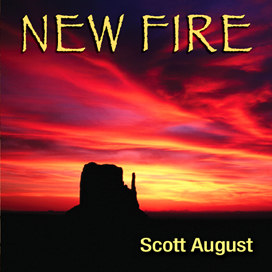
A lot of people ask me what flutes I use to record with. So I thought I'd take a moment and go through each CD over the next few months and talk about them in a little detail, starting with New Fire. I'll also talk a little about each track and link to previous posts about the track, flute or maker, if there are any.
Heart of the Sky
This piece is in the key of G with the flute in G pentatonic minor (from now on all keys are pentatonic minor (1-3-4-5-7) unless stated otherwise). The flute is a Scott Loomis flute.

Loomis G
This flute really sings and seemed to really fit the mood of this song. It's got a clear, singing tone with a touch of sweetness.
Heart of the Sky started out as a rhythm that I would improvise to. The original track was composed right after Distant Spirits but I didn't get down to recording the tune till much later. In fact in its first incarnation it was played on two flutes, one of which was a clay drone flute, and neither of these flutes were in G.
Heart of the Sky started out as a rhythm that I would improvise to. The original track was composed right after Distant Spirits but I didn't get down to recording the tune till much later. In fact in its first incarnation it was played on two flutes, one of which was a clay drone flute, and neither of these flutes were in G.
The title comes from my many visits to the Grand Canyon. The view from the rim seems to go on forever, to the heart of the sky.
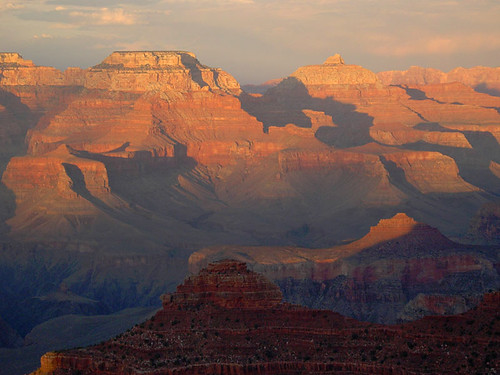
One of the Mayan gods of creation was named Heart of Sky and there is also a Hopi deity named Heart of the Sky.
For a more detailed look at this flute visit my earlier post Loomis Native American flute
Recently I tend to play this song live on a J.P. Gomez aspen flute that I got after New Fire was finished. I still play the Loomis flute, but for this song J.P.'s seems to be better live. I've already recorded a piece for my fifth CD with this flute. J.P. lives in Sedona and makes excellent flutes. If you don't have one of his you should seriously consider adding one to your collection.
For a more detailed look at this flute visit my earlier post Loomis Native American flute
Recently I tend to play this song live on a J.P. Gomez aspen flute that I got after New Fire was finished. I still play the Loomis flute, but for this song J.P.'s seems to be better live. I've already recorded a piece for my fifth CD with this flute. J.P. lives in Sedona and makes excellent flutes. If you don't have one of his you should seriously consider adding one to your collection.
For a closer look at J.P. Gomez's flute visit Find out more about J.P. Gomez
Mockingbird Canyon
Key of F# played on a Moonlight Creek F# aspen flute. The opening tune for this piece popped into my head one day while practicing scales and technical exercises. Set against a rhythm of udus and tablas the tune is joined by an acoustic guitar, charrangos and other Latin guitar-like instruments. I like the crisp sound of aspen flutes, however they water out very quickly and take forever to dry.
Mockingbird Canyon is a real place in Chaco Canyon National Park, NM. Although the park is know for it's giant prehispanic buildings, Mockingbird Canyon is a quiet side canyon without any ancient structures that I know of.
I want to take a moment to talk about Moonlight Creek flutes by Michael Gulino. Michael is a good friend of mine having met him through flutes. He's never made a ton of flutes, but each one I own by him is a jewel. I don't have a favorite flute, but if I had to pick a favorite my G NAF by him would be on the short list of the flutes I might choose. Michael's flutes have a clarity and singing quality that is very rare in NAFs. Their thin walls give his flutes a very unique, yet classic sound. His flutes are completely made by hand. He doesn't even use a lathe to shape them but sands them down with sandpaper, by hand.
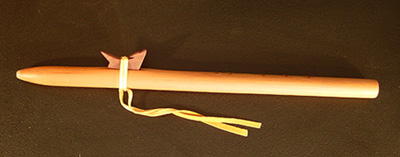
My Moonlight Creek G
It's hard to put into words, but in my mind the sound of Michael's flute embodies the haunting bittersweet sound of the NAF. The sound that captures peoples souls. Michael is a very talented person. He's always looking for new challenges. Sadly for the flute world he is not making many flutes and told me recently that when he sells what flutes he has left he plans to stop making them completely. Any one who owns one of Michael's wonderful instruments will understand me when I say this is a loss for the NAF world.
For a more in depth look at one of Michael's flutes see my earlier post on Gulino and Yazzie flutes
For a more in depth look at one of Michael's flutes see my earlier post on Gulino and Yazzie flutes
Turquoise Twilight
This piece is in G. I don't remember what flute I used on it. Seriously...
The title came to me during a drive from LA to Phoenix when the sun was sinking behind me and the sky all around was turning the many hues of turquoise, red, vermilion, salmon, pink, light blues, dark blues and black. The peaceful sensation from these colors seemed to match this piece perfectly.
The title came to me during a drive from LA to Phoenix when the sun was sinking behind me and the sky all around was turning the many hues of turquoise, red, vermilion, salmon, pink, light blues, dark blues and black. The peaceful sensation from these colors seemed to match this piece perfectly.
Ravens & Redtails
Another piece in G using the same Loomis flute from Heart of the Sky. This is another piece that began as a live sketch right after Distant Spirits to fill out my performances. When the mood strikes me I'll even perform the kalimba part live. The title comes from a road trip I took once where Ravens kept flying across the road and higher up in the sky above the highway Redtail hawks soared in the air currents. There are also lot of South American and Latin American guitars in this piece like Mockingbird Canyon.
New Fire
New Fire is the title track and was performed on a Queaztcoatzl double flute made by Guillermo Martinez. This particular flute was one of his first doubles and is marked #2 on the back. I showed it to him a few years ago and he didn't remember making it, but I purchased it directly from him.
Made of what looks to be yellow cedar, this flute is tuned in 4ths and has metal "nests" for the totems or birds to rest on.
This is another piece that started as a rhythm for live performances to improvise on top of, which I then expanded into a larger piece. Ironically I still use the original "live" version in concert and never switched over to the version that's on the CD.
Made of what looks to be yellow cedar, this flute is tuned in 4ths and has metal "nests" for the totems or birds to rest on.
This is another piece that started as a rhythm for live performances to improvise on top of, which I then expanded into a larger piece. Ironically I still use the original "live" version in concert and never switched over to the version that's on the CD.
The name New Fire comes from the New Fire ceremony which is performed by many the Hopi as part of the large Wuwuchim ceremony. Simply put it is a New Years ceremony, but in reality it is much more complex than that. It has a long history and a version of it dates back to Aztec times when it was performed every 52 years. Jessie Walter Fewkes, an American anthropologist, archaeologist, writer who supervised excavations at Mesa Verde, thought that evidence exists indicating that the New Fire ceremony was performed at Mesa Verde during the 10th and 11th centuries.
Sedona Sunrise
This piece is the only flute solo on New Fire and was performed on a Yazzie flute made of Cocobolo.

Yazzie cocobolo flute
Cocobolo is part of the Rosewood family, which is used a lot in instrument construction. Guitars are know for having parts of them made with Rosewood.
This piece was recorded before the title came to me. This is usually how it works. Just after I had finished the song I was visiting Sedona and driving early one morning to an appearance I was doing in the area. The rays of the sun were low in the sky and the cliffs were bright red and pink, as if they were lighted from the inside.
This piece was recorded before the title came to me. This is usually how it works. Just after I had finished the song I was visiting Sedona and driving early one morning to an appearance I was doing in the area. The rays of the sun were low in the sky and the cliffs were bright red and pink, as if they were lighted from the inside.

Read more about the Yazzie Cocobolo flute.
Cactus Dance
Sometimes ideas come during time when you don't expect them to. The seed for this song was planted during a concert I gave years ago while I was demonstrating different kinds of flutes. I spent just a few minutes talking about non standard Native American flutes: Clay flutes, drone flutes, double flutes, bass flutes... Anything that the average person might not have seen before.
One of the flutes I demonstrated was a High Spirits drone. High Spirit drone are joined at the mouthpiece and then flare out like a "V". This particular flute had an altered drone tuning which could be exploited to great effect. I played a short but fast little improvisation through a very bouncy delay. At that time I was recording all my performances and when I got back to my studio it seemed that there was the beginnings of piece there. So a few months later when I got the chance I developed it into a real piece.
One of the flutes I demonstrated was a High Spirits drone. High Spirit drone are joined at the mouthpiece and then flare out like a "V". This particular flute had an altered drone tuning which could be exploited to great effect. I played a short but fast little improvisation through a very bouncy delay. At that time I was recording all my performances and when I got back to my studio it seemed that there was the beginnings of piece there. So a few months later when I got the chance I developed it into a real piece.
Cactus Dance bounces along with a very energetic rhythm with a middle section that pulls back and becomes more dreamy. There are hints of Andean music throughout the piece.
The version on the album was recorded using the High Spirits flute and for a while I was dragging that instrument around to perform the song live. However, given it's V shape it wouldn't fit into my flute bags and caused me to have to carry it around in a cardboard box. This got to be a pain, the box started to fall apart and a couple times the flute fell out.
The version on the album was recorded using the High Spirits flute and for a while I was dragging that instrument around to perform the song live. However, given it's V shape it wouldn't fit into my flute bags and caused me to have to carry it around in a cardboard box. This got to be a pain, the box started to fall apart and a couple times the flute fell out.
Due to this I had stopped playing the song live until Richard Halliburton sent me plans for a flute he was asked to make by one of his customers. I never could figure out what that flute was for. It was in a very odd tuning and scale. However, when I looked at it I saw that if he made it in the normal (so called) minor pentatonic scale, the 1-3-4-5-7 pentatonic, I would have a flute that would look like other drones but would have the altered drone tuning I wanted. So now I can play Cactus Dance live again but on Rich's flute.
Rich is an up and coming flute maker from the LA area. One of his flute won first place at the first Oklahoma Flute festival and they are quite striking. He uses a lot of onlay, inlay and semi precious gemstones in his flutes.
Rich is an up and coming flute maker from the LA area. One of his flute won first place at the first Oklahoma Flute festival and they are quite striking. He uses a lot of onlay, inlay and semi precious gemstones in his flutes.

The Rich Halliburton drone
The title for this song comes from it's South American influence and my memories of visiting far southern Arizona. There cactus are everywhere. Barrel, Cholla, Saguaro abound. The rays of early morning and late afternoon sunlight dancing on their spines.
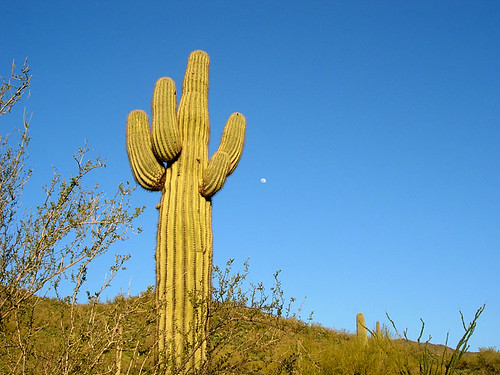
To read more about this piece and to learn more about Rich Halliburton and the flutes used on Cactus Dance visit Two Tunable Drones
Sombra de La Luna
Performed on a clay "Moon Goddess flute made by Xavier Quijas Yxayotl.
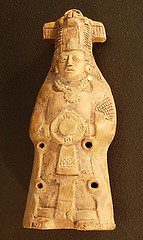
Clay flutes were very common in the ancient Mexican and the Mayan cultures. Excavations and early accounts show evidence for this. I have seen photos of a pit used for offering and clay flutes with a trumpet shaped bells are among the many objects that were throw in the pit to the Gods. Clay flutes do not have the front chamber that Native American flutes have but instead have the flue placed in the mouthpiece. This is the more common type of construction for fipple flutes. NAFs are the exception to the rule.
Once again this piece got it's start from a live improve I gave once. Originally I recorded a solo version of it for Sacred Dreams but I felt that there was still much more that could be done with the tune and the sound of the flute so I rearranged a version that was longer and had more instruments. This is the version on New Fire which combines the flute with piano, some treated percussion and very atmospheric tones.
Take a closer look at this flute
Temple of the Sun
Recorded on a Guillermo Martinez double flute Temple of the Sun is the longest piece on New Fire. It begins with a solo and is later joined by a hypnotic percussion beat over the quiet drone of didgeridoos.

The flute is made of wood and the longer half is tuned to D while the shorter half is tuned to A.
I posted an in-depth article about this flute which is still accessible.
I posted an in-depth article about this flute which is still accessible.
Ancient Memories
Although this tune comes later in sequence on the disc it was the first to be composed for New Fire. I had just obtained a Hawk and Geri Littlejohn bass G flute and my first Yazzie flute having just met them. I thought it would be fun to write a piece for a flute and it's bass counterpart.
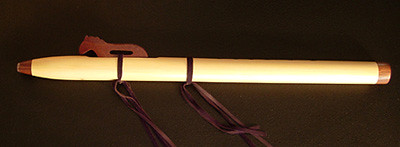
Yazzie G flute
Right after Distant Spirits came out I was asked to do a workshop for the NCFC on recording a NAF with a computer. I used this piece in that workshop since it was still in production.
Sacred Night
This is the only piece on New Fire where the flute was recorded live during a performance, taken back to the studio where the rest of the instruments were added to it. The piece is in D#/Eb and is played on a Ken Light flute. This is my favorite Ken Light flute. It has a good clean sound but with just a little buzz for character. The fingering on mine is not his usual fingering but the standard NAF fingering of playing the octave by holding down the fourth hole from the bottom.
The flute part itself was an improvisation to which the other parts were layered in weeks later. This is always a fun way to work for me as I enjoy the challenge of working around a recording that is locked down. I did do some processing toward the end where the flute returns as a faint echo in a texture of sounds.
In my mind as I was working on this piece was the memory of a trip I made to Flagstaff, passing through Keyenta, or K-Town as the locals call it, and Tuba city on Hwy 160. The road passes through Tsegi, Shonto, Cow Springs and Tonalea on the north while the cliffs of Black Mesa rise to the south. As the sun began to touch the horizon the sky began to light up in multi chromatic hues.
I began to take photos of the changing scenery and light while driving down the highway. It was one of the most beautiful sunsets I've ever seen and Arizona is known for it's beautiful sunsets. One of the shots made it into the booklet for New Fire.
Well, that's a look at New Fire. We'll look at my other CDs in the near future.
© CEDAR MESA MUSIC. THIS ARTICLE AND ALL IMAGES AND SOUND FILES ARE THE PROPERTY OF CEDAR MESA MUSIC. ALL RIGHTS RESERVED. UNAUTHORIZED DUPLICATION (COPYING) IN ANY FORM IS ILLEGAL AND IS A VIOLATION OF ALL COPYRIGHT LAWS. THIS INCLUDES, BUT IS NOT LIMITED TO, USING ON YOUR BLOG OR MYSPACE PAGE.
The flute part itself was an improvisation to which the other parts were layered in weeks later. This is always a fun way to work for me as I enjoy the challenge of working around a recording that is locked down. I did do some processing toward the end where the flute returns as a faint echo in a texture of sounds.
In my mind as I was working on this piece was the memory of a trip I made to Flagstaff, passing through Keyenta, or K-Town as the locals call it, and Tuba city on Hwy 160. The road passes through Tsegi, Shonto, Cow Springs and Tonalea on the north while the cliffs of Black Mesa rise to the south. As the sun began to touch the horizon the sky began to light up in multi chromatic hues.
I began to take photos of the changing scenery and light while driving down the highway. It was one of the most beautiful sunsets I've ever seen and Arizona is known for it's beautiful sunsets. One of the shots made it into the booklet for New Fire.
Well, that's a look at New Fire. We'll look at my other CDs in the near future.
© CEDAR MESA MUSIC. THIS ARTICLE AND ALL IMAGES AND SOUND FILES ARE THE PROPERTY OF CEDAR MESA MUSIC. ALL RIGHTS RESERVED. UNAUTHORIZED DUPLICATION (COPYING) IN ANY FORM IS ILLEGAL AND IS A VIOLATION OF ALL COPYRIGHT LAWS. THIS INCLUDES, BUT IS NOT LIMITED TO, USING ON YOUR BLOG OR MYSPACE PAGE.
Tuesday, August 12, 2008
Anasazi Signature flute prototype tests
As many of you know Geoffrey Ellis and I went through many different prototypes to get the instrument we were looking for. When playing over the phone didn't cut it I made a video clip with my digital still camera. I placed it on a bookshelf to get the mouthpiece in view. Then I emailed it to Geoffrey.
The "ticking" on the soundtrack is the camera's auto focus. Other than that, this is a completely dry take. No reverb or delay.
The "ticking" on the soundtrack is the camera's auto focus. Other than that, this is a completely dry take. No reverb or delay.
Thursday, August 07, 2008
Scales and Modes part 2
THE MODES
READ THE FULL ARTICLE
In the previous section we looked at how major scales are made up of a sequence of whole and half steps. That every major scale has a half step between notes 3 - 4 and 7 - 8. If you move the root note you need to also move the sequence of whole and half steps. Also, that while a major diatonic scale based on the note C has no sharps or flats, if you move the root note up to D both the F and C notes have to be sharp for the sequence to be correct.
But what would happen if we played the notes from D to D but this time we played just the white keys -the notes that make up the C major scale? This would force the sequence of whole and half steps to change and in doing so would construct a completely different scale. Scales that are made up like this, using the notes of a major diatonic scale but starting on a note other than the root, are called modes. Modes are nothing more than a variation of the sequence of whole and half steps.
Let's take a closer look at this.READ THE FULL ARTICLE
Sunday, July 20, 2008
INAFA Convention 2998
I got back from the INAFA convention last week and thought I'd share a little of my time there. This won't be a review of the event but more like a journal of my time there. This was one of the best, if not the best, organized events, flute or otherwise, I've ever had the pleasure of attending. The schedule was well laid out, the venue was almost perfect, the sound guy knew what he was doing and everything seemed to go off like clock work. Most of credit belongs to Kathleen Joyce-Grendahl. The Exec Dir of INAFA. She was greatly assisted by members of the Clear Water Flute Circle. They all did a great job!
THE JOURNEY
Just getting to Eau Claire was amazing for me. My flight from LAX to Minneapolis went over many of my favorite places on earth.

First we flew over one of the main routes out of southern California, the "Cajon Pass" which heads through the Mojave desert to Las Vegas and on into Utah.
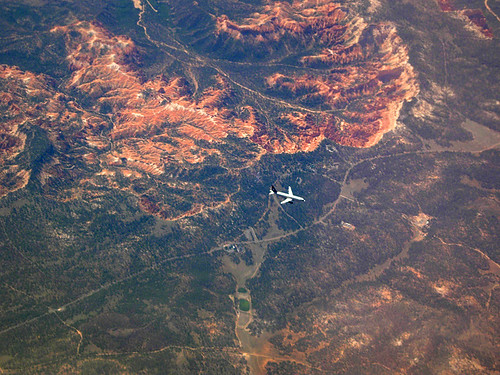
After flying directly over Las Vegas and Lake Mead the jet passed Zion and then Bryce Canyon National Park. A UPS plane flew passed below us as we crossed over Sunset Point, the Visitor's Center, Rubys and the town of Tropic.
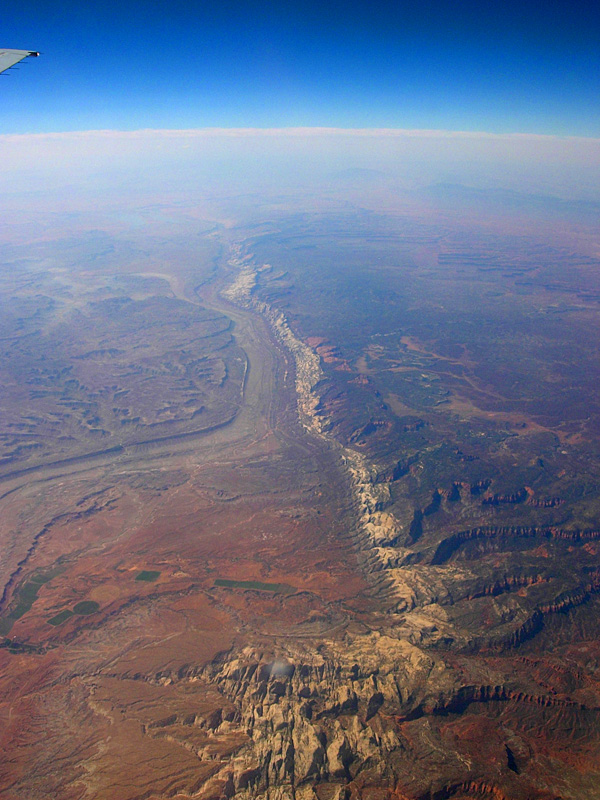
The next major site was Capitol Reef National Park. This is a off-the-beat park in south central Utah. One of the last areas of the country to get regular mail service.
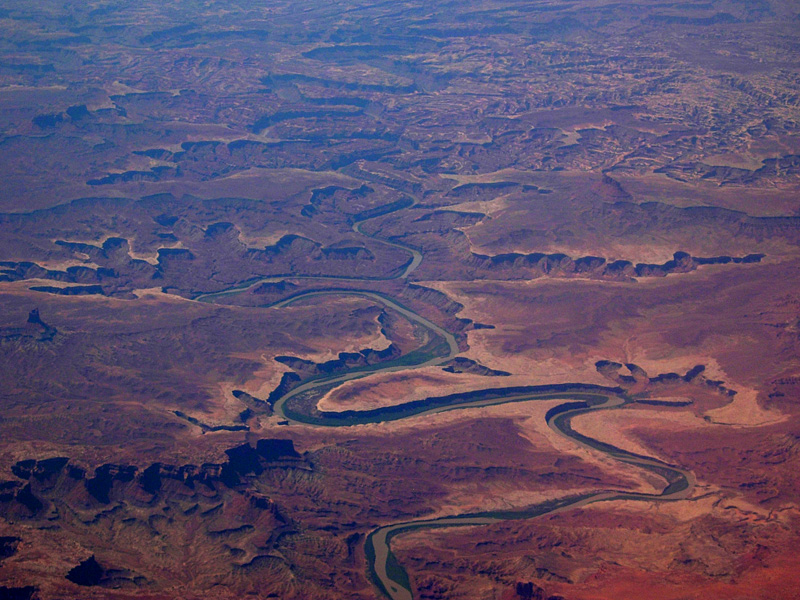
Next was Canyonlands National Park. This is where the Green and Colorado rivers meet. It is a land of sun baked canyons with two ribbons of green meandering through them. My last free MP3 download was inspired by a back country four-wheel drive trip I took along the stretch of river shown above.
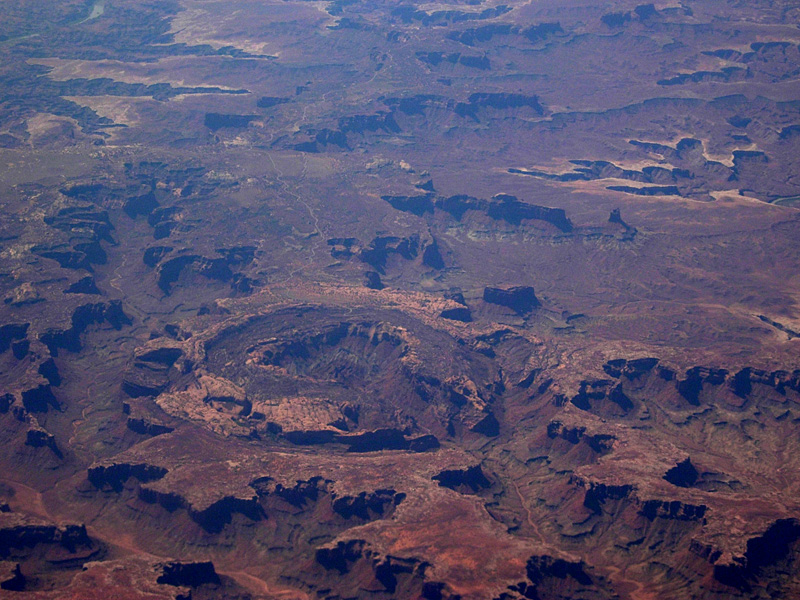
Further to the east is the Upheaval Dome. A very odd geologic feature. Now thought to be the strike of a meteor it was once thought that underground salt erupted from this site. The drainage from in the lower right portion of the dome is very interesting. Something that one doesn't see as clearly from the ground.
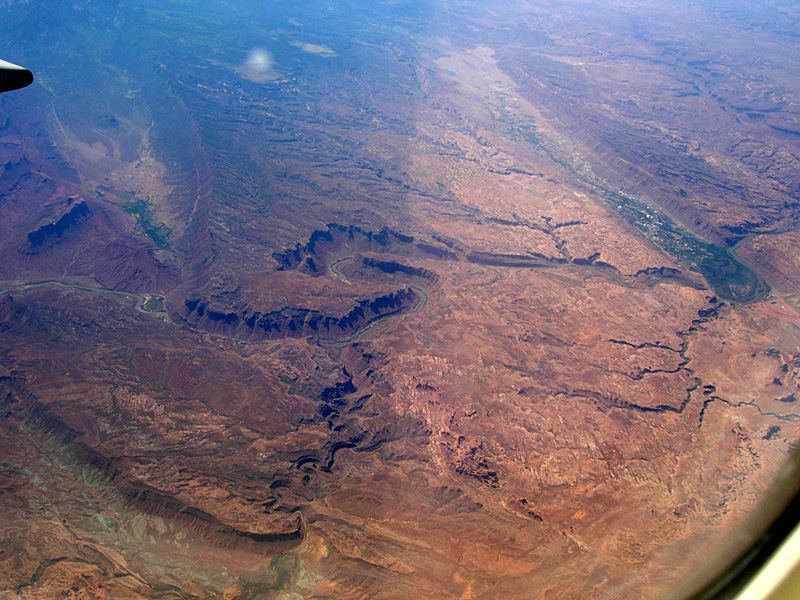
Here is the town of Moab, UT the strip of green on the far right, and Castle Valley on the far left. Between the two snakes the Colorado river and Hwy 128, one of the most scenic roads in the country. Below that is Arches National Park. We flew over Balancing Rock, the Windows section and Delicate Arch.
THE CONVENTION
The INAFA convention was held in the little city of Eau Claire, WI. People came from all over the country to attend.
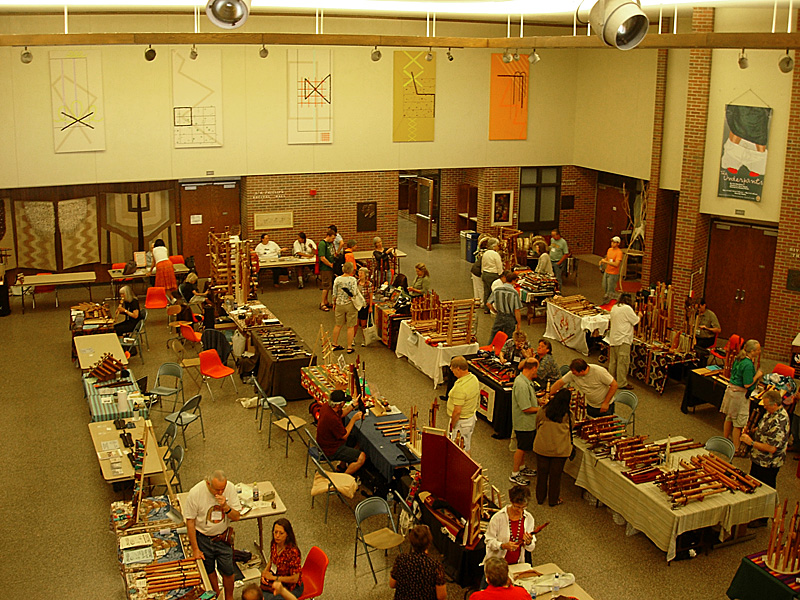
The vendors and artist set up their tables in the lobby of the Haas Fine Arts Building.
I met up with a lot of my friends and made new ones. Here are some of them in alphabetical order.
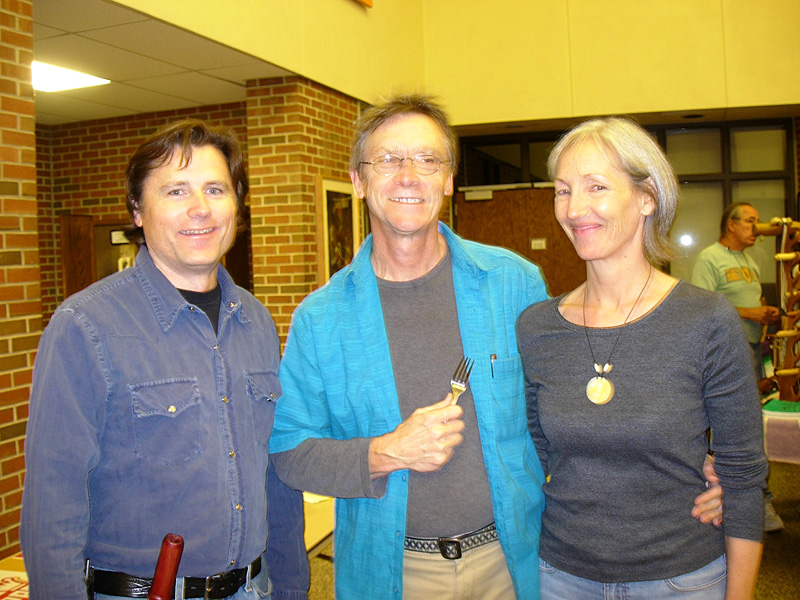
Mary Jane and Michael Graham Allen, aka Coyote Oldman and Coyote Oldman Flutes.
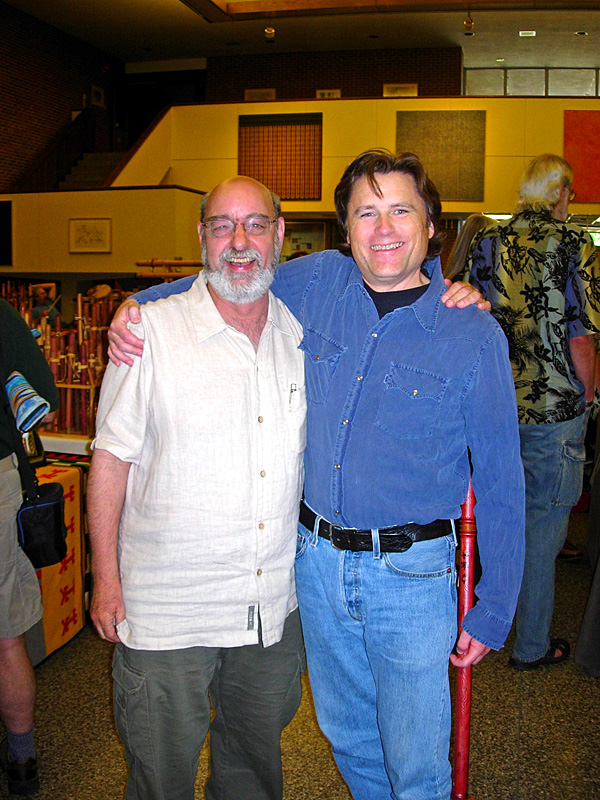
Bobb Fantauzzo
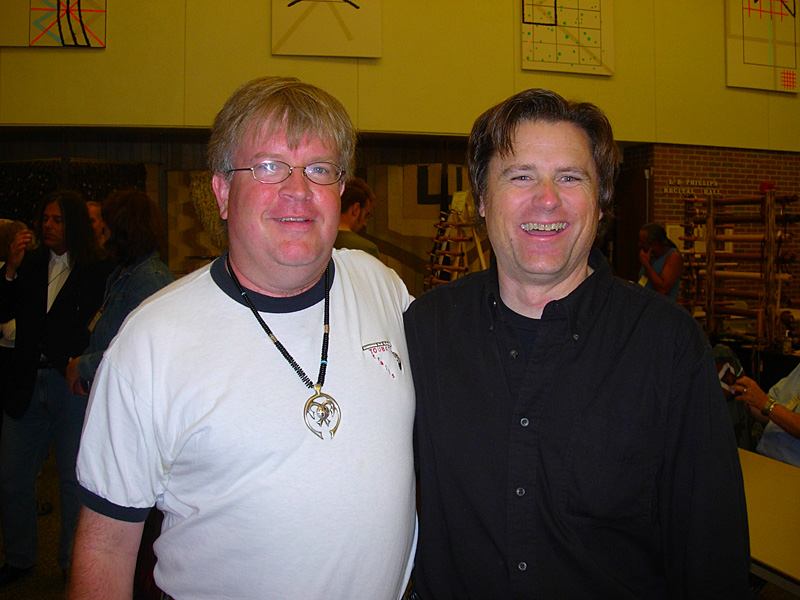
Robert Gatliff

Keith and Kathleen Joyce-Grendahl

John Kulias of Meadowlark Flutes -ceramic flutes!

Colyn and Kitty Peterson of Woodland Voices flutes
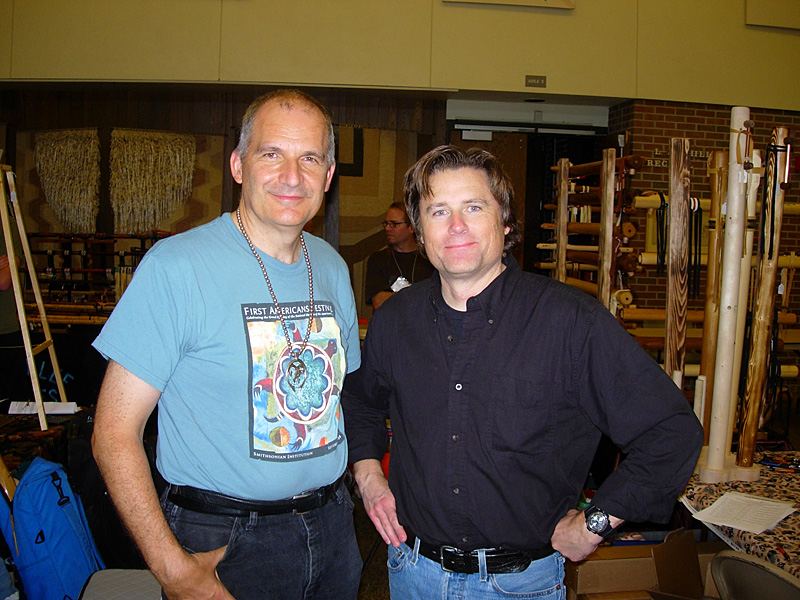
John Sarantos
I took some photos of Jeff and Jo Ann of the Oregon Flute Store, but they were out of focus...
All of the makers shown can be found on the Makers page of my website. You can find INAFA in the links section or just just click on the link here.
Well that's it until the next convention...
THE JOURNEY
Just getting to Eau Claire was amazing for me. My flight from LAX to Minneapolis went over many of my favorite places on earth.

First we flew over one of the main routes out of southern California, the "Cajon Pass" which heads through the Mojave desert to Las Vegas and on into Utah.

After flying directly over Las Vegas and Lake Mead the jet passed Zion and then Bryce Canyon National Park. A UPS plane flew passed below us as we crossed over Sunset Point, the Visitor's Center, Rubys and the town of Tropic.

The next major site was Capitol Reef National Park. This is a off-the-beat park in south central Utah. One of the last areas of the country to get regular mail service.

Next was Canyonlands National Park. This is where the Green and Colorado rivers meet. It is a land of sun baked canyons with two ribbons of green meandering through them. My last free MP3 download was inspired by a back country four-wheel drive trip I took along the stretch of river shown above.

Further to the east is the Upheaval Dome. A very odd geologic feature. Now thought to be the strike of a meteor it was once thought that underground salt erupted from this site. The drainage from in the lower right portion of the dome is very interesting. Something that one doesn't see as clearly from the ground.

Here is the town of Moab, UT the strip of green on the far right, and Castle Valley on the far left. Between the two snakes the Colorado river and Hwy 128, one of the most scenic roads in the country. Below that is Arches National Park. We flew over Balancing Rock, the Windows section and Delicate Arch.
THE CONVENTION
The INAFA convention was held in the little city of Eau Claire, WI. People came from all over the country to attend.

The vendors and artist set up their tables in the lobby of the Haas Fine Arts Building.
I met up with a lot of my friends and made new ones. Here are some of them in alphabetical order.

Mary Jane and Michael Graham Allen, aka Coyote Oldman and Coyote Oldman Flutes.

Bobb Fantauzzo

Robert Gatliff

Keith and Kathleen Joyce-Grendahl

John Kulias of Meadowlark Flutes -ceramic flutes!

Colyn and Kitty Peterson of Woodland Voices flutes

John Sarantos
I took some photos of Jeff and Jo Ann of the Oregon Flute Store, but they were out of focus...
All of the makers shown can be found on the Makers page of my website. You can find INAFA in the links section or just just click on the link here.
Well that's it until the next convention...
Tom Vezo
In my journey with the Native American flute I've been lucky to meet a lot of really great people. Most are just NAF folks that play for fun, others come from other interests but share a love for the NAF. One of those was Tom Vezo.
Tom was an incredibility talented photographer. His speciality was wildlife photography and his focus was birds. It was quite a shock that I learned that Tom died Friday afternoon ( July 18th, 2008) while hiking in the Rincon mountains of AZ. I've spoken one of his close friends and the details are still slim. He was 61.
Tom was a very dedicated and passionate person. He was also one of the original members of the Tucson Native American Flute Circle.
The family has requested no flowers...Donations may be made in Tom's memory to Defenders Committee of the Friends of Madera Canyon; P.O. Box 1203; Green Valley, AZ. 85622
If you have a love of the wild and a love and respect for birds as I do you owe it to yourself to check out his site www.tomvezo.com.
Here is some more information about Tom from the Green Valley News and Sun:
Tom Vezo's work is widely published in the United States and Europe in many books, calendars, magazines and advertisements. His credits include: Audubon, Birder’s World, Bird Watcher’s Digest, Discovery, Ducks Unlimited, National Geographic, National Wildlife Federation, Nature Conservancy, Nature’s Best, Natural History, Outdoor Photographer, Sierra Club, Travel and Leisure, Wildbird, Wildlife Conservation and many more.
He was winner of 1998 and 1999 Nature's Best Magazines photo contest for “Wildlife” in the professional category and the BBC Wildlife photographer of the year in 1997 as an honorable mention.
He was recognized as one of the top bird photographers in the United States but also photographed landscapes all over the world. He led many photography tours throughout the United States and Canada teaching people the techniques of nature photography in the field. His expansive photo library contained more than 400,000 images.
Passionate about preserving Madera Canyon, Vezo helped publicize organizations like Friends of Madera Canyon and The Defenders of Madera Canyon on his Web site and in his monthly e-mailed newsletters, illustrating many of his causes with photos of the endangered areas.
Tom was an incredibility talented photographer. His speciality was wildlife photography and his focus was birds. It was quite a shock that I learned that Tom died Friday afternoon ( July 18th, 2008) while hiking in the Rincon mountains of AZ. I've spoken one of his close friends and the details are still slim. He was 61.
Tom was a very dedicated and passionate person. He was also one of the original members of the Tucson Native American Flute Circle.
The family has requested no flowers...Donations may be made in Tom's memory to Defenders Committee of the Friends of Madera Canyon; P.O. Box 1203; Green Valley, AZ. 85622
If you have a love of the wild and a love and respect for birds as I do you owe it to yourself to check out his site www.tomvezo.com.
Here is some more information about Tom from the Green Valley News and Sun:
Tom Vezo's work is widely published in the United States and Europe in many books, calendars, magazines and advertisements. His credits include: Audubon, Birder’s World, Bird Watcher’s Digest, Discovery, Ducks Unlimited, National Geographic, National Wildlife Federation, Nature Conservancy, Nature’s Best, Natural History, Outdoor Photographer, Sierra Club, Travel and Leisure, Wildbird, Wildlife Conservation and many more.
He was winner of 1998 and 1999 Nature's Best Magazines photo contest for “Wildlife” in the professional category and the BBC Wildlife photographer of the year in 1997 as an honorable mention.
He was recognized as one of the top bird photographers in the United States but also photographed landscapes all over the world. He led many photography tours throughout the United States and Canada teaching people the techniques of nature photography in the field. His expansive photo library contained more than 400,000 images.
Passionate about preserving Madera Canyon, Vezo helped publicize organizations like Friends of Madera Canyon and The Defenders of Madera Canyon on his Web site and in his monthly e-mailed newsletters, illustrating many of his causes with photos of the endangered areas.
Sunday, July 06, 2008
Echoes From The Mesa, Summer 2008
The Scott August Newsletter
The Summer 2008 newsletter is up. In it you can find information about the following:
 Ancient Light DVD to air on PBS
Ancient Light DVD to air on PBS
 Flute Class: Intermediate NAF & Beginning Anasazi flute
Flute Class: Intermediate NAF & Beginning Anasazi flute
 Native American flutes Scales and Modes: part 1
Native American flutes Scales and Modes: part 1
 New MP3 Download (Emailing List Member's)
New MP3 Download (Emailing List Member's)
 Appearances
Appearances
 Reviews
Reviews
 Anasazi Signature flutes
Anasazi Signature flutes
If you are a member of Scott August's Emailing visit the member's section of www.cedarmesa.com or www.scottaugust.com to find the member's version of this newsletter.
If you are not a member you can become one at any time by going to the Sign Up page.
The Summer 2008 newsletter is up. In it you can find information about the following:
If you are a member of Scott August's Emailing visit the member's section of www.cedarmesa.com or www.scottaugust.com to find the member's version of this newsletter.
If you are not a member you can become one at any time by going to the Sign Up page.
Sunday, June 22, 2008
Scales and Modes part 1
During my travels, workshops and performances I'm asked many times by Native American flute players and audience members about the scale of the Native American flute. Surprisingly, even among long time players and makers, there seems to be some confusion about the scale and the other modes that can be played on a NAF. Many people don't know what the scale is and it is often mislabeled as a "native "scale which, in it's most common form today, it is not.
History tells us that at one time the scales of the Native American flute varied greatly and that there was no standardized scale system. Today however, the NAF is most commonly tuned to the minor pentatonic scale, a western scale which like most, if not all, "western" scales can trace it's roots back to ancient Greece.
But what makes a scale minor pentatonic? Or major pentatonic? Or major, the most common western scale? Is a scale the same as a key, and if not, how do they differ? To understand the the scale of the Native American flute it's best to understand how scales are constructed. Not only will this give the player and maker a better understanding of the Native American flute, it will make them better musicians. For behind knowing about scales lies the secrets to what musical keys are all about, which different keyed flutes sound good together, what different modes sound good together and what is meant by terms such as Diatonic, Pentatonic, Major, Minor and Mode. These terms come up with increasing frequency during flute circles, online disscusion groups and between individual players and makers.
In this series of posts we're going to try to answer these questions in a way that is simple for a non-musician to understand. Be warned however that this can not be done without getting into some theory. You will discover however that you already know much of this information intuitively. Personally I have always found theory to be fun. It's like a puzzle. You start by working with a couple of pieces, then with whole sections and soon you have a complete image.
Don't forget, it's just music. It's not brain surgery...
SCALES AND MODES:
WHAT ARE THEY AND HOW DO THEY WORK?
The most common scale on the Native American flute is the minor pentatonic. However with a little change of fingering other scales can be played. Since these scales will all relate to each other as they have some common notes they can be considered as "sub-scales" of a main, or parent scale. These sub-scales are better know as modes. Modes have been around for hundreds of years. The two most common modes are the Ionian, better known as the Major scale and the Aeolian better known as the Minor scale. As you can see the words scale and mode tend to be used to mean the same thing even though they're not the same. They are related however. We're not going to go into that here (if you want to get deep into this spend some time doing a Google search or poke around Wikipedia, there's lots of information out there.) but for the purposes of making this easier to understand let's try to simplify this down to the basics.
Let's start with a major scale...
Read the full article
© 2008 Cedar Mesa Music - Scott August
History tells us that at one time the scales of the Native American flute varied greatly and that there was no standardized scale system. Today however, the NAF is most commonly tuned to the minor pentatonic scale, a western scale which like most, if not all, "western" scales can trace it's roots back to ancient Greece.
But what makes a scale minor pentatonic? Or major pentatonic? Or major, the most common western scale? Is a scale the same as a key, and if not, how do they differ? To understand the the scale of the Native American flute it's best to understand how scales are constructed. Not only will this give the player and maker a better understanding of the Native American flute, it will make them better musicians. For behind knowing about scales lies the secrets to what musical keys are all about, which different keyed flutes sound good together, what different modes sound good together and what is meant by terms such as Diatonic, Pentatonic, Major, Minor and Mode. These terms come up with increasing frequency during flute circles, online disscusion groups and between individual players and makers.
In this series of posts we're going to try to answer these questions in a way that is simple for a non-musician to understand. Be warned however that this can not be done without getting into some theory. You will discover however that you already know much of this information intuitively. Personally I have always found theory to be fun. It's like a puzzle. You start by working with a couple of pieces, then with whole sections and soon you have a complete image.
Don't forget, it's just music. It's not brain surgery...
SCALES AND MODES:
WHAT ARE THEY AND HOW DO THEY WORK?
The most common scale on the Native American flute is the minor pentatonic. However with a little change of fingering other scales can be played. Since these scales will all relate to each other as they have some common notes they can be considered as "sub-scales" of a main, or parent scale. These sub-scales are better know as modes. Modes have been around for hundreds of years. The two most common modes are the Ionian, better known as the Major scale and the Aeolian better known as the Minor scale. As you can see the words scale and mode tend to be used to mean the same thing even though they're not the same. They are related however. We're not going to go into that here (if you want to get deep into this spend some time doing a Google search or poke around Wikipedia, there's lots of information out there.) but for the purposes of making this easier to understand let's try to simplify this down to the basics.
Let's start with a major scale...
Read the full article
© 2008 Cedar Mesa Music - Scott August
Tuesday, June 03, 2008
Artist group protests `orphan' copyright bill
I'm sure I'm violating some copyright law in posting this so let me say clearly this is from The Boston Herald. I believe this might be of interest to the Native American flute community as we create music, art, photos and many other things that might fall prey to this pending bill. There is also some links at the bottom for more information about this.
-Scott August
Artist group protests `orphan' copyright bill
By DAVID WILDMAN -- The Boston Herald , May 22, 2008 Thursday ALL EDITIONS
The Orphan Works Act seems innocuous enough: a federal bill designed to help museums and libraries use works of art if the creators are unknown, something they can't do under current copyright law.
Don't believe it, says a group of Massachusetts-based artist organizations and volunteer lawyers. They claim the bill now sailing through the House and Senate will radically restructure copyright law and infringe artists' rights.
``What they are doing is, in effect, reversing the order of copyright law,'' said Brad Holland of the Marshfield-based Illustrators Partnership of America. ``This bill shifts the presumption of ownership from the creator to the public.''
The bill was originally devised to help museums, libraries and documentary filmmakers access images and artworks whose author is unknown. For example, a museum with a collection of Depression-era photos could not put it on their Web site under current copyright law without getting permission from each of the photographers, which would be nearly impossible.
The Orphan Works Act solves this problem, but goes much further. It allows any work of art to be used for free by anyone who files notice that they are conducting a ``diligent search'' for the creator. It also calls for the creation of a privately run database where artists must register their work or run the risk of having it declared ``orphan.''
``It's like killing a mosquito with a machine gun,'' said Jim Grace of Boston's Volunteer Lawyers for the Arts. ``I think it's being driven by commercial interests.''
Under this bill, artists would have to register their works for a fee to receive copyright protection that is now free. The database could be run by an Internet company such as Google (one of the bill's backers), which would stand to make a huge profit.
Bill co-sponsor Sen. Patrick Leahy (D-Vt.) declined to comment but released a statement: ``We have worked to strike the right balance to protect the interests of copyright owners and potential users of orphan works.''
``That's bull,'' said Cynthia Turner of the Illustrators Partnership. ``If they really wanted to create orphan works legislation to do what (Leahy) says, they could bring in new, spehttp://www.blogger.com/img/gl.link.gifcial, very defined uses. Latitude could be allowed in using works where the copyright owner couldn't be located or identified.''
In response to the outcry against the bill, U.S. Rep. Bill Delahunt (D-Quincy) wants to give artists more of a say.
``It's been a while since we've heard from that many people from the artists community,'' said Mark Forest, Delahunt's chief of staff. ``If they're concerned, we're concerned.''
Contact your Rep Tell them you are against the Orphan copyright bill. You can email them or better yet, call them!
LINKS
nikondigital.org
arstechnica.com
Copyright Clearance Center
U.S. Copyright Office page
-Scott August
Artist group protests `orphan' copyright bill
By DAVID WILDMAN -- The Boston Herald , May 22, 2008 Thursday ALL EDITIONS
The Orphan Works Act seems innocuous enough: a federal bill designed to help museums and libraries use works of art if the creators are unknown, something they can't do under current copyright law.
Don't believe it, says a group of Massachusetts-based artist organizations and volunteer lawyers. They claim the bill now sailing through the House and Senate will radically restructure copyright law and infringe artists' rights.
``What they are doing is, in effect, reversing the order of copyright law,'' said Brad Holland of the Marshfield-based Illustrators Partnership of America. ``This bill shifts the presumption of ownership from the creator to the public.''
The bill was originally devised to help museums, libraries and documentary filmmakers access images and artworks whose author is unknown. For example, a museum with a collection of Depression-era photos could not put it on their Web site under current copyright law without getting permission from each of the photographers, which would be nearly impossible.
The Orphan Works Act solves this problem, but goes much further. It allows any work of art to be used for free by anyone who files notice that they are conducting a ``diligent search'' for the creator. It also calls for the creation of a privately run database where artists must register their work or run the risk of having it declared ``orphan.''
``It's like killing a mosquito with a machine gun,'' said Jim Grace of Boston's Volunteer Lawyers for the Arts. ``I think it's being driven by commercial interests.''
Under this bill, artists would have to register their works for a fee to receive copyright protection that is now free. The database could be run by an Internet company such as Google (one of the bill's backers), which would stand to make a huge profit.
Bill co-sponsor Sen. Patrick Leahy (D-Vt.) declined to comment but released a statement: ``We have worked to strike the right balance to protect the interests of copyright owners and potential users of orphan works.''
``That's bull,'' said Cynthia Turner of the Illustrators Partnership. ``If they really wanted to create orphan works legislation to do what (Leahy) says, they could bring in new, spehttp://www.blogger.com/img/gl.link.gifcial, very defined uses. Latitude could be allowed in using works where the copyright owner couldn't be located or identified.''
In response to the outcry against the bill, U.S. Rep. Bill Delahunt (D-Quincy) wants to give artists more of a say.
``It's been a while since we've heard from that many people from the artists community,'' said Mark Forest, Delahunt's chief of staff. ``If they're concerned, we're concerned.''
Contact your Rep Tell them you are against the Orphan copyright bill. You can email them or better yet, call them!
LINKS
nikondigital.org
arstechnica.com
Copyright Clearance Center
U.S. Copyright Office page
Wednesday, May 21, 2008
New Age Reporter review of Lost Canyons
Bill Binkelman reviewed Lost Canyons for New Age Reporter and we thought we'd like to share it with you...
"It alarms me that an artist of Scott August's caliber managed to release five recordings (his sixth is coming very soon) and I have only now heard his music. Guess I'm not such an icon in the industry after all, am I? I named this to my best of 2007 list, but it's even better than that. I'd place it in my top ten for Native-influenced fusion music, period. Yeah, high praise, but after playing this album at least ten times prior to writing this review, I'm sure it belongs there.
August plays way too many specific instruments to recount here, but among them are flutes (primarily the Anasazi flute which this recording seems to pay tribute to), piano, percussion, guitars, ethnic instruments such as the kalimba gamelan, and "textures" which I take to mean the application of synthesizers in assorted permutations. In this last aspect, August should give lessons to others as his dexterous superb blending of synths adds just the right amount to any song on which it's featured. Never too over the top yet also not so subtle as to make the listener question whether anything has been added at all. He's also an amazing percussionist across the full spectrum of the drums and other instruments which he uses on the CD.
Variety is the catch word here, as Lost Canyons contains everything from the plaintive beauty of the opening "Morning Star" (Anasazi flute, alabaster chimes and textures, the latter two coming into play later in the song) to the lively "Raven Dance" which intermixes percussion from just about every continent with guitar, piano and Tiger Maple flute. And those are just the first two songs on the album"
Post continues here
© Cedar Mesa Music
"It alarms me that an artist of Scott August's caliber managed to release five recordings (his sixth is coming very soon) and I have only now heard his music. Guess I'm not such an icon in the industry after all, am I? I named this to my best of 2007 list, but it's even better than that. I'd place it in my top ten for Native-influenced fusion music, period. Yeah, high praise, but after playing this album at least ten times prior to writing this review, I'm sure it belongs there.
August plays way too many specific instruments to recount here, but among them are flutes (primarily the Anasazi flute which this recording seems to pay tribute to), piano, percussion, guitars, ethnic instruments such as the kalimba gamelan, and "textures" which I take to mean the application of synthesizers in assorted permutations. In this last aspect, August should give lessons to others as his dexterous superb blending of synths adds just the right amount to any song on which it's featured. Never too over the top yet also not so subtle as to make the listener question whether anything has been added at all. He's also an amazing percussionist across the full spectrum of the drums and other instruments which he uses on the CD.
Variety is the catch word here, as Lost Canyons contains everything from the plaintive beauty of the opening "Morning Star" (Anasazi flute, alabaster chimes and textures, the latter two coming into play later in the song) to the lively "Raven Dance" which intermixes percussion from just about every continent with guitar, piano and Tiger Maple flute. And those are just the first two songs on the album"
Post continues here
© Cedar Mesa Music
Wednesday, May 07, 2008
Spring Gathering Photos...for real
Thanks to Denise Halliburton I now have photos from the Spring Gathering in Georgetown.
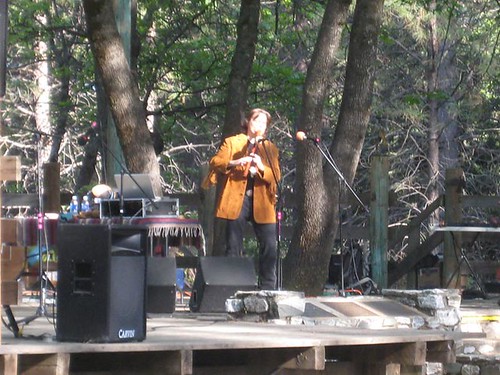
The 2nd annual "Spring Gathering" sponsored by the NCFC NoNahme Clan Clan was April 26th, 2008. Lew Price worked hard to make this year's festival a success and succeeded with flying colors. Unlike the first festival the weather was great! Warm clear skies and no rain. There was a large turnout of people, flute makers and flutes players.
Post continues here

The 2nd annual "Spring Gathering" sponsored by the NCFC NoNahme Clan Clan was April 26th, 2008. Lew Price worked hard to make this year's festival a success and succeeded with flying colors. Unlike the first festival the weather was great! Warm clear skies and no rain. There was a large turnout of people, flute makers and flutes players.
Post continues here
Saturday, May 03, 2008
Lost Canyons #2 on Echoes Top 25
Cedar Mesa Music is proud to announce that Lost Canyons hit #2 on the Echoes Top 25 playlist for April 2008. Echoes is one of the largest syndicated New Age radio programs in the nation heard on 130 stations.
Lost Canyons has also been in the top five of the New Age Reporter playlist for the last three months. You can read more reviews or listen to samples from Lost Canyons on the Cedar Mesa Music website.
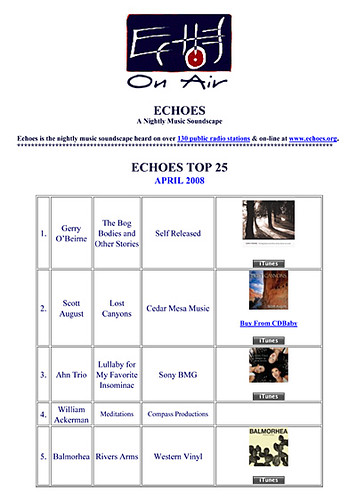
Back to Cedar Mesa Music News
Lost Canyons has also been in the top five of the New Age Reporter playlist for the last three months. You can read more reviews or listen to samples from Lost Canyons on the Cedar Mesa Music website.

Back to Cedar Mesa Music News
Spring Gathering Photos...sort of
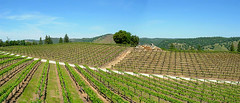
I've posted some notes and photos from the Spring Gathering in Georgetown last weekend. During the festival I was too busy teaching workshops and performing to take photos but after my Sunday workshop I went out with some friends to see the surrounding area. Georgetown is just up the road from where gold was discovered in California in 1848 and there are lot of wineries in the area, being one of the oldest wine growing regions in the state.
Post continues here
Friday, May 02, 2008
Intermediate/Advanced NAF workshop
Native American Music Award winner Scott August is coming to the Bay Area and will be giving an Intermediate/Advanced NAF workshop in Napa, CA
If you feel you've reached a plateau with your Native American flute playing this workshop is perfect for you. Learn the secrets to spicing up your NAF playing and improvising. Make the leap to the next level.
Learn the tricks that make you sound like a pro!
Intermediate/Advanced NAF workshop
Date: May 10th, 2008
Time: 1:00 pm Class will be 90 minutes long
Place: 793 La Salle Way, Napa, CA, 94559
Cost: $40
Class size is limited. To reserve your space send an email to Cedar Mesa Music or take your chances and just show up.
If you feel you've reached a plateau with your Native American flute playing this workshop is perfect for you. Learn the secrets to spicing up your NAF playing and improvising. Make the leap to the next level.
Learn the tricks that make you sound like a pro!
- Vibrato control
- How to make your flute chirp
- Advanced ornamentation including trills and turns
- Tonguing techniques for more expressive articulation
- Flutter tonguing
- How to improvise like a pro
Intermediate/Advanced NAF workshop
Date: May 10th, 2008
Time: 1:00 pm Class will be 90 minutes long
Place: 793 La Salle Way, Napa, CA, 94559
Cost: $40
Class size is limited. To reserve your space send an email to Cedar Mesa Music or take your chances and just show up.
Thursday, April 24, 2008
Flute Wraps
Some of my best friends belong to the Tucson Native American Flute Circle, TNAFC. I've talked about Keith Stanford before and profiled one of his flutes. Another friend of mine is really two people, Ed and Fran Pendrys of Juniper Flute Accessories.
Juniper Flute Accessories makes tasteful flute stands and bags. They also make really nice flute wraps. Something you won't find on their website for some reason.
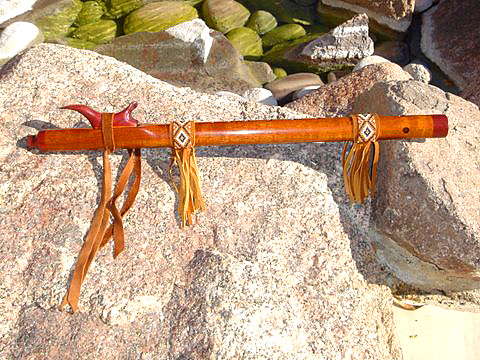
Here is an example of one of their wraps on a Geoffrey Ellis flute.
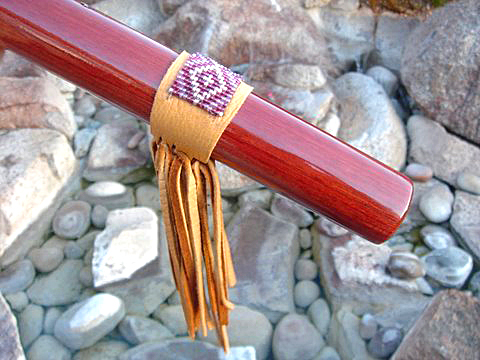
They do really nice bead work on beautiful leather. All of this is done by Fran on a small loom. She doesn't do a lot of them since, as with so many people in the Native flute world, she wants it to be fun -not a job.
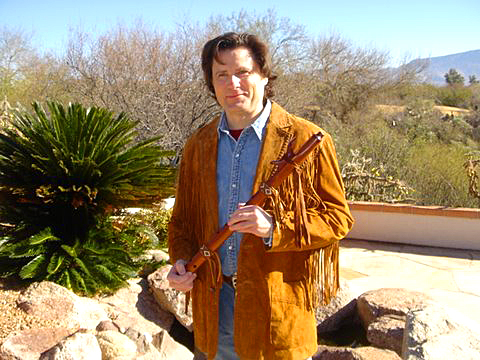
I consider myself very fortunate to have a few of these great wraps. They look great and really dress up a flute. If you're interested in one email them through their website.
Juniper Flute Accessories makes tasteful flute stands and bags. They also make really nice flute wraps. Something you won't find on their website for some reason.

Here is an example of one of their wraps on a Geoffrey Ellis flute.

They do really nice bead work on beautiful leather. All of this is done by Fran on a small loom. She doesn't do a lot of them since, as with so many people in the Native flute world, she wants it to be fun -not a job.

I consider myself very fortunate to have a few of these great wraps. They look great and really dress up a flute. If you're interested in one email them through their website.
Sunday, April 13, 2008
Sandhill Crane flute
Here are some images of a Sandhill Crane flute by Greg Jones
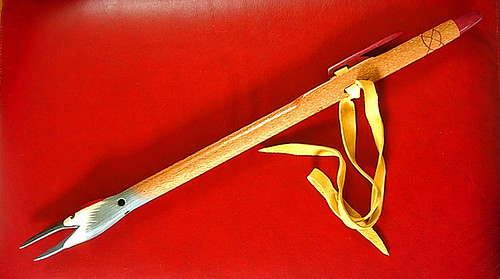
The body is made of lacewood.
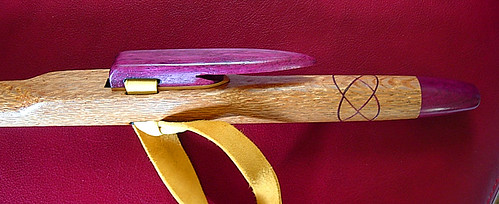
The block and mouthpiece are made from rosewood. Note the celtic inlay of rosewood too.
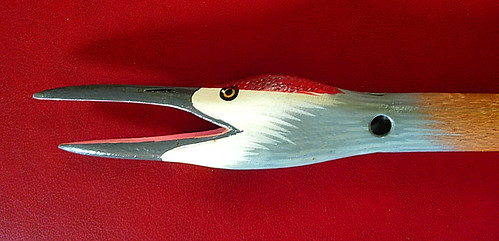
The carved head extremely well done. This flute is in the key of Bb and has a sweet, clear tone that carries well.
Sandhill Cranes are the most common crane in the American Southwest with their distictive red head. They are found all over the U.S., Canada and even Seberia.
Greg Jones can be found in Oregon. He does not sell flutes directly but my understanding is that you can possiblly get one by contacting The Flute Case store. I have also heard rumor that Querencia Woodwinds might begin selling them this summer. If you have any interest I would suggest you contact them.

The body is made of lacewood.

The block and mouthpiece are made from rosewood. Note the celtic inlay of rosewood too.

The carved head extremely well done. This flute is in the key of Bb and has a sweet, clear tone that carries well.
Sandhill Cranes are the most common crane in the American Southwest with their distictive red head. They are found all over the U.S., Canada and even Seberia.
Greg Jones can be found in Oregon. He does not sell flutes directly but my understanding is that you can possiblly get one by contacting The Flute Case store. I have also heard rumor that Querencia Woodwinds might begin selling them this summer. If you have any interest I would suggest you contact them.
Thursday, April 10, 2008
Scott August Signature Anasazi flutes
 Cedar Mesa Music and Scott August are proud to announce the Scott August Signature Anasazi Flute. These professional quality instruments are made by Geoffrey Ellis of Earth Tone Flutes and are perfect for both beginning and advanced players. Ideal for concert stage, recording studios or just nooding around alone as you discover your true Kokopelli.
Cedar Mesa Music and Scott August are proud to announce the Scott August Signature Anasazi Flute. These professional quality instruments are made by Geoffrey Ellis of Earth Tone Flutes and are perfect for both beginning and advanced players. Ideal for concert stage, recording studios or just nooding around alone as you discover your true Kokopelli.Scott and Geoffrey worked closely together to construct a flute that had the distinctive warm, low sound that Scott strives for in his recordings while still keeping ease of playing in mind. Several prototypes were constructed and extensively tested. The final designs were then field tested by members of Scott's beginning Anasazi flute class before Scott and Geoffrey made their final decision. The result is a warm, resonant low tone with a silky smooth response.
To satisfy both the collector and the everyday flute player these flutes will be available in two lines
The Scott August Signature Ansaszi Flute
and
The Scott August Anasazi Flute Series
The Scott August Signature Ansaszi Flute
Shown above, this is a limited edition flute. Only twenty five flutes will be offered per year, each year will it's own distinct design. Made of eastern red cedar The Scott August Signature Anasazi Flute is tastefully accented with a crushed turquoise Cedar Mesa Music logo and Bore Rings in a style reminiscent of Chaco Canyon jewelry. Each flute will be signed by Scott August, Numbered and come with a Certificate of Authenticity, a bag and maintenance kit.
Available in the keys of Ab and A these flutes will be made to order to accommodate both right and left handed players. See below for prices and availability.
The Scott August Anasazi Flute Series
 Also made of eastern red cedar the Scott August Anasazi Flute Series is a more affordable version of the Signature flute accented with a wood burned Cedar Mesa Music logo and Bore Rings. Each flute will come with a bag and a flute maintenance kit.
Also made of eastern red cedar the Scott August Anasazi Flute Series is a more affordable version of the Signature flute accented with a wood burned Cedar Mesa Music logo and Bore Rings. Each flute will come with a bag and a flute maintenance kit.Available in the keys of Ab and A, with other keys to be anounced, these flutes will be made to order to accommodate both right and left handed players. See below for prices and availability.
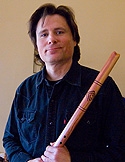
The Scott August Ansaszi Flute Series
Prices and Availability
These flutes will be available starting April 21th, 2008
The Scott August Signature Ansaszi Flute:
Price: $350.00 One of 25 Signed and numbered flutes. Keys available: Ab and A
Comes with a certificate of authenticity, a bag and maintenance kit
The Scott August Anasazi Flute Series
Price: $235.00. Keys available: Ab and A. Other keys to be anounced.
Comes with a bag and maintenance kit
How to order
To order your flute send the following information to Cedar Mesa Music
- Name
- Address
- City, State, Zip
- Phone
- Email
- Which Key?
Tell us which hand you place on the bottom holes –right or left?
We don’t need a deposit
Once we get this information you’ll be put on the list. It’s “first come first flute...”
© Cedar Mesa Music
Monday, March 24, 2008
Anasazi flute class review
I know the posts have been a little light lately, but I'm hoping to start posting more frequently. To start off I thought I'd show some photos from the Anasazi flute class I gave earlier this month for the Inland Empire Flute Circle. All the photos were taken by Barbara Garliner, the IEFC's de facto official photographer.
The class met in the future home of the Dorthy Ramon Learning Center, a non profit group that is dedicated to saving and sharing all Southern California’s American Indian cultures, languages, history, music, and other traditional arts.
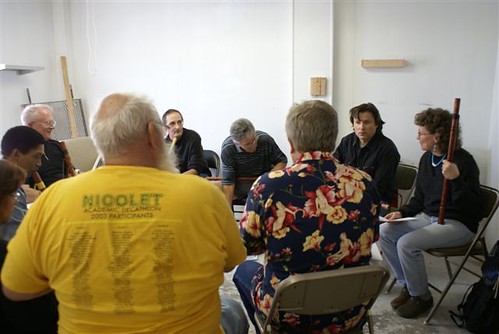
The class was made up of about eight very brave people as the Anasazi flute takes a strong will to learn to play for most people. We've looked at this flute in great detail in earlier posts so I won't go into that here.
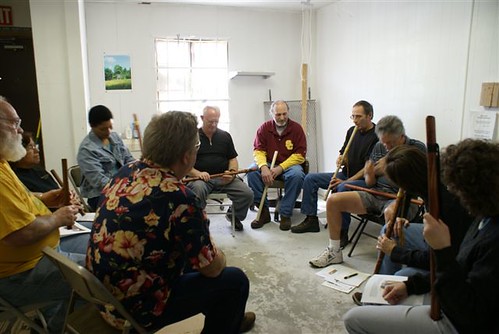
Everyone had to get a flute for the class and some did not have them very long before class day. A few chose to maker their own. A double challenge.
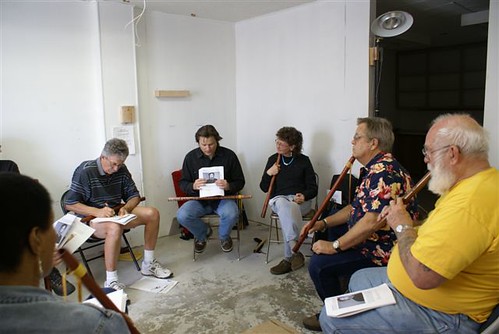
The first thing we did was to talk about the embouchure, or lip position that the player needs to learn to play the flute. Unlike the NAF the vast majority of people can't just pick up an Anasazi flute and get a tone right away. It can take days, weeks, even months of practice and the embouchure is extremely important.
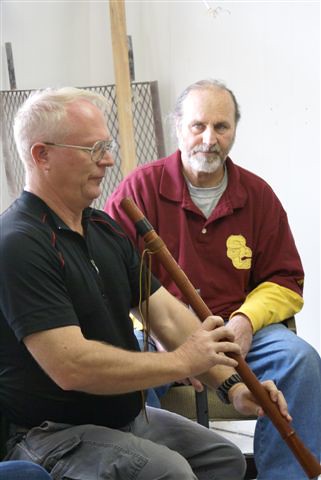
Each member of the class got to try it out for themselves and I was able to tailor my comments to every one's individual needs.
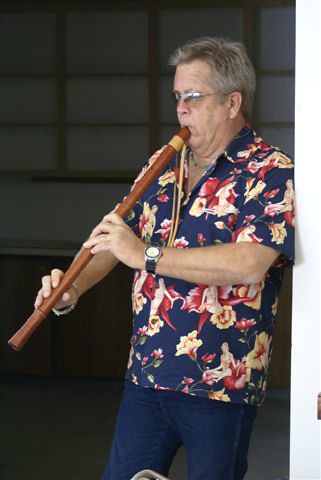
In addition to the homemade PVC Anasazi flute we had a professional maker of Native American style flutes, Rich Halliburton of Querencia Woodwinds. Rich and I are good friends but I don't know what other "woodwinds" he makes besides flutes. His NAF's however are very nice and one of his flutes won top prize at last years Oklahoma Flute Festival. John Stillwell was also at the circle meeting as was Steve Meier a budding flute maker who was there to debut some of his flutes.

Here is a photo of Michelle. She is in the military and if I remember correctly was a captain in the navy. Not many women can play the Anasazi flute due to the long length of the bore. In the photo she is playing an Ab (G#) and if she was smaller and could not reach the finger holes of this key she could try one in the key of A. I know of a maker that is planing to make some Anasazi flutes in Bb so that more women can play them. Coincidentally, I've been doing some digging lately into the original Anasazi flutes that were found by Earl Morris in "Broken Flute Cave" and it turns out that they are reported to have been in the key of Bb so these shorter flutes will still be authentic to the prehistoric ones.
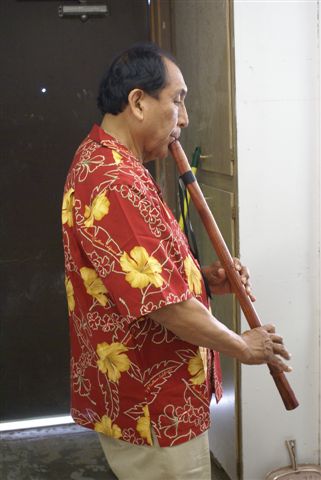
Here's a photo of Ernest Siva giving the Anasazi flute a try. Ernest is a elder of the Morrongo tribe and grew up on the Morongo Indian Reservation located in the San Gorgonio pass. The culture of this area had flutes very similar to the Anasazi flute but shorter and with a narrower bore and only four holes. Several of these are in a museum in Riverside and Marvin and Jonette Yazzie of Yazzie Flutes have made recreations of them. They are really hard to play and the pitch class of the scale is still a mystery.
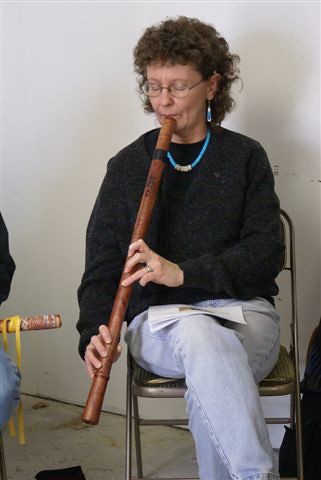
Speaking of Jonette Yazzie, here is a photo of her playing an Anasazi flute. Her playing position is not the best but as she is not that tall she found that holding the flute a little to the side was the only way she could reach the bottom finger holes. Like Michelle (shown above), Jonette is playing an Ab.

We also looked at a recreation of a Hopi flute that was in use as recently as 120 years ago. These flutes continued to be used after the Anasazi flute apparently fell out of use about A.D. 1250, which coincides with the great migration out of the four corners area and, some believe, the appearance of the kachina cult.
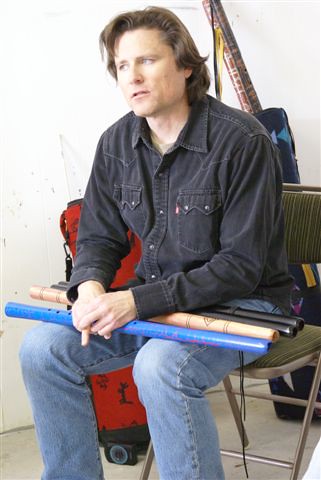
At the end of class I showed everyone some prototypes of some Anasazi flutes by a maker new to these instruments. I handed them out to the class to get some feedback on how they played for beginners. We'll look at these Anasazi flute in greater depth in a later article.
If you're interested in trying to learn to play one of these flutes I'm giving a class in Northern California on April 26 as part of the Northern California Flute Circle Spring Gathering Festival. To find out more here.
The class met in the future home of the Dorthy Ramon Learning Center, a non profit group that is dedicated to saving and sharing all Southern California’s American Indian cultures, languages, history, music, and other traditional arts.

The class was made up of about eight very brave people as the Anasazi flute takes a strong will to learn to play for most people. We've looked at this flute in great detail in earlier posts so I won't go into that here.

Everyone had to get a flute for the class and some did not have them very long before class day. A few chose to maker their own. A double challenge.

The first thing we did was to talk about the embouchure, or lip position that the player needs to learn to play the flute. Unlike the NAF the vast majority of people can't just pick up an Anasazi flute and get a tone right away. It can take days, weeks, even months of practice and the embouchure is extremely important.

Each member of the class got to try it out for themselves and I was able to tailor my comments to every one's individual needs.

In addition to the homemade PVC Anasazi flute we had a professional maker of Native American style flutes, Rich Halliburton of Querencia Woodwinds. Rich and I are good friends but I don't know what other "woodwinds" he makes besides flutes. His NAF's however are very nice and one of his flutes won top prize at last years Oklahoma Flute Festival. John Stillwell was also at the circle meeting as was Steve Meier a budding flute maker who was there to debut some of his flutes.

Here is a photo of Michelle. She is in the military and if I remember correctly was a captain in the navy. Not many women can play the Anasazi flute due to the long length of the bore. In the photo she is playing an Ab (G#) and if she was smaller and could not reach the finger holes of this key she could try one in the key of A. I know of a maker that is planing to make some Anasazi flutes in Bb so that more women can play them. Coincidentally, I've been doing some digging lately into the original Anasazi flutes that were found by Earl Morris in "Broken Flute Cave" and it turns out that they are reported to have been in the key of Bb so these shorter flutes will still be authentic to the prehistoric ones.

Here's a photo of Ernest Siva giving the Anasazi flute a try. Ernest is a elder of the Morrongo tribe and grew up on the Morongo Indian Reservation located in the San Gorgonio pass. The culture of this area had flutes very similar to the Anasazi flute but shorter and with a narrower bore and only four holes. Several of these are in a museum in Riverside and Marvin and Jonette Yazzie of Yazzie Flutes have made recreations of them. They are really hard to play and the pitch class of the scale is still a mystery.

Speaking of Jonette Yazzie, here is a photo of her playing an Anasazi flute. Her playing position is not the best but as she is not that tall she found that holding the flute a little to the side was the only way she could reach the bottom finger holes. Like Michelle (shown above), Jonette is playing an Ab.

We also looked at a recreation of a Hopi flute that was in use as recently as 120 years ago. These flutes continued to be used after the Anasazi flute apparently fell out of use about A.D. 1250, which coincides with the great migration out of the four corners area and, some believe, the appearance of the kachina cult.

At the end of class I showed everyone some prototypes of some Anasazi flutes by a maker new to these instruments. I handed them out to the class to get some feedback on how they played for beginners. We'll look at these Anasazi flute in greater depth in a later article.
If you're interested in trying to learn to play one of these flutes I'm giving a class in Northern California on April 26 as part of the Northern California Flute Circle Spring Gathering Festival. To find out more here.
Subscribe to:
Comments (Atom)